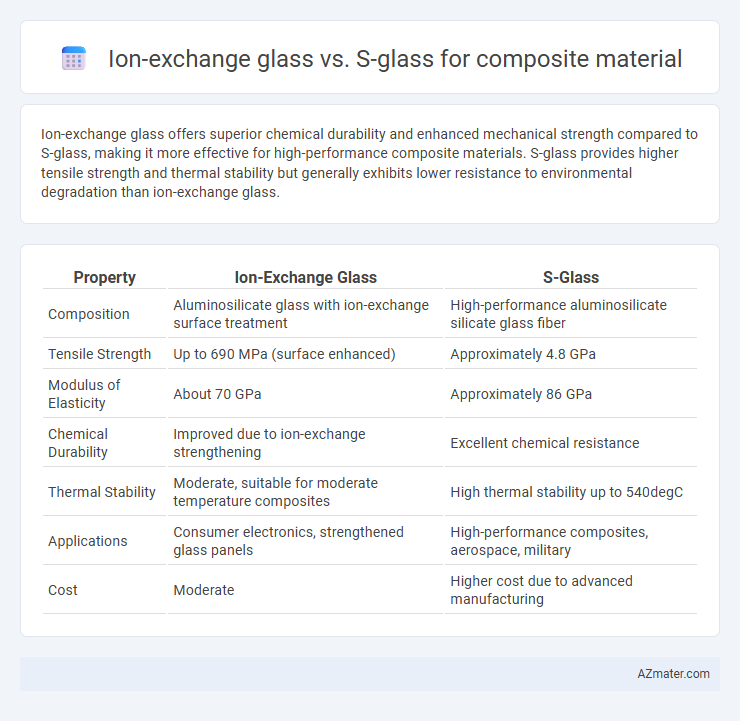Ion-exchange glass offers superior chemical durability and enhanced mechanical strength compared to S-glass, making it more effective for high-performance composite materials. S-glass provides higher tensile strength and thermal stability but generally exhibits lower resistance to environmental degradation than ion-exchange glass.
Table of Comparison
| Property | Ion-Exchange Glass | S-Glass |
|---|---|---|
| Composition | Aluminosilicate glass with ion-exchange surface treatment | High-performance aluminosilicate silicate glass fiber |
| Tensile Strength | Up to 690 MPa (surface enhanced) | Approximately 4.8 GPa |
| Modulus of Elasticity | About 70 GPa | Approximately 86 GPa |
| Chemical Durability | Improved due to ion-exchange strengthening | Excellent chemical resistance |
| Thermal Stability | Moderate, suitable for moderate temperature composites | High thermal stability up to 540degC |
| Applications | Consumer electronics, strengthened glass panels | High-performance composites, aerospace, military |
| Cost | Moderate | Higher cost due to advanced manufacturing |
Introduction to Composite Materials
Ion-exchange glass enhances mechanical strength and chemical durability in composite materials by replacing smaller ions with larger ones on the glass surface, creating compressive stress. S-glass, known for its high tensile strength and superior impact resistance, is a high-performance alumino-silicate glass fiber commonly used in composites requiring enhanced structural performance. These materials optimize composites for applications in aerospace, military, and high-performance sporting goods, where strength-to-weight ratio and durability are critical.
Overview of Ion-Exchange Glass
Ion-exchange glass is a type of strengthened glass where smaller ions in the glass surface are replaced by larger ions from a molten salt bath, creating a compressive stress layer that significantly enhances its mechanical strength and durability. This surface treatment provides ion-exchange glass with superior resistance to scratches, impact, and chemical corrosion compared to S-glass, which is a high-strength glass fiber primarily known for its high tensile strength and thermal stability in composites. The ion-exchange process improves the performance of glass used in composite materials by increasing toughness and extending service life under demanding environmental conditions.
Properties of S-Glass in Composites
S-Glass exhibits superior tensile strength with values up to 4.9 GPa and a high modulus of elasticity around 86 GPa, making it ideal for high-performance composite applications. Its excellent thermal stability, with a glass transition temperature exceeding 700degC, ensures durability under extreme conditions. Enhanced resistance to chemical attack and fatigue further positions S-Glass as a preferable reinforcement material in aerospace and military-grade composites.
Mechanical Strength Comparison
Ion-exchange glass exhibits superior mechanical strength compared to S-glass due to the compressive surface layer formed during the ion-exchange process, significantly enhancing its resistance to surface flaws and tensile stress. S-glass, known for its high tensile strength and modulus, provides excellent mechanical performance but generally falls short of the enhanced toughness and durability achieved by ion-exchange strengthened glass in composite materials. The ion-exchange process can improve glass strength by up to 200%, making ion-exchange glass a preferred choice for high-performance composites requiring exceptional mechanical reliability.
Durability and Chemical Resistance
Ion-exchange glass provides superior chemical resistance due to its strengthened surface, making it more resistant to alkali and acidic environments compared to S-glass. S-glass offers high tensile strength and durability, excelling in mechanical performance but with relatively lower chemical resistance in harsh environments. In composite materials, ion-exchange glass enhances longevity in chemically aggressive settings, whereas S-glass is preferred for applications demanding high mechanical durability.
Impact on Composite Flexibility
Ion-exchange glass enhances composite flexibility by creating a compressive stress layer on the surface, which improves strain tolerance and resistance to crack propagation compared to S-glass. S-glass offers high tensile strength and stiffness but delivers less flexibility due to its rigid fiber structure. The ion-exchange process modifies the glass ion matrix, resulting in composites with superior impact resistance and energy absorption under bending loads than those reinforced with standard S-glass fibers.
Thermal Properties and Stability
Ion-exchange glass exhibits superior thermal stability compared to S-glass, with a higher glass transition temperature (Tg) typically around 550degC, enhancing composite material performance under elevated temperatures. S-glass, primarily composed of alumino-silicate fibers, offers moderate thermal resistance with a Tg near 480degC, but ion-exchange glass's enhanced ion mobility control reduces thermal expansion and improves resistance to thermal shock. This increased thermal stability of ion-exchange glass composites makes them ideal for applications requiring long-term durability in high-temperature environments.
Weight Considerations in Design
Ion-exchange glass offers a higher strength-to-weight ratio compared to S-glass, enabling lighter composite designs without compromising structural integrity. S-glass provides enhanced tensile strength but generally results in slightly heavier composites due to its higher density. Weight-sensitive applications benefit from ion-exchange glass, optimizing performance through reduced mass and sustained durability.
Cost-effectiveness Analysis
Ion-exchange glass offers enhanced surface strength through a chemical strengthening process, resulting in improved durability for composite materials but incurs higher production costs compared to S-glass. S-glass, known for its superior tensile strength and thermal stability, provides a cost-effective alternative for composite reinforcement with lower material and processing expenses. The choice between ion-exchange glass and S-glass in composites depends on balancing the increased mechanical performance of ion-exchange glass against the more economical properties and widespread availability of S-glass.
Applications and Industry Use Cases
Ion-exchange glass exhibits superior compressive strength and chemical durability, making it ideal for aerospace and automotive composites requiring high impact resistance and thermal stability. S-glass, renowned for its high tensile strength and excellent fatigue resistance, is extensively used in marine, sports equipment, and construction industries where lightweight reinforcement is critical. Both materials optimize composite performance but are selected based on specific mechanical demands and environmental conditions within diverse industrial applications.

Infographic: Ion-exchange glass vs S-glass for Composite material
 azmater.com
azmater.com